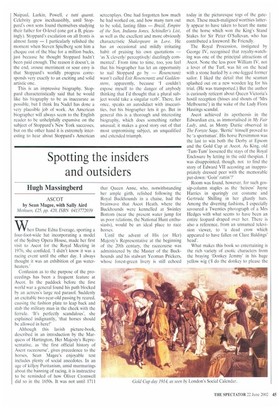Spotting the insiders and outsiders
Hugh Massingberd ASCOT by Sean Magee, with Sally Aird Methuen, £25, pp. 420. ISBN 0413772039 When Dame Edna Everage, sporting a four-foot-wide hat incorporating a model of the Sydney Opera House, made her first visit to Ascot for the Royal Meeting in 1976, she confided, 'I didn't know it was a racing event until the other day. I always thought it was an exhibition of gas waterheaters.'
Confusion as to the purpose of the proceedings has been a frequent feature at Ascot. In the paddock before the first world war a general found his path blocked by an actress's large red parasol. Suddenly an excitable two-year-old passing by reared, causing the fashion plate to leap back and stab the military man in the cheek with the ferrule. It's perfectly scandalous', she explained indignantly, `that horses should be allowed in here!'
Although this lavish picture-book, described in an introduction by the Marquess of Hartington, Her Majesty's Representative, as 'the first official history of Ascot racecourse', gives precedence to the horses, Sean Magee's enjoyable text includes plenty of social anecdotes. In an age of killjoy Puritanism, amid murmurings about the banning of racing, it is instructive to be reminded of how Oliver Cromwell did so in the 1650s. It was not until 1711 that Queen Anne, who, notwithstanding her ample girth, relished following the Royal Buckhounds in a chaise, had the brainwave that Ascot Heath, where the Buckhounds were kennelled at Swinley Bottom (near the present water jump for us poor relations, the National Hunt enthusiasts), would be an ideal place to race horses.
Until the advent of His (or Her) Majesty's Representative at the beginning of the 20th century, the racecourse was administered by the Master of the Buckhounds and his stalwart Yeoman Prickers, whose forest-green livery is still echoed today in the picturesque togs of the gatemen. These much-maligned worthies latterly appear to have taken to heart the name of the horse which won the King's Stand Stakes for Sir Peter O'Sullevan, who has contributed a foreword: Be Friendly.
The Royal Procession, instigated by George IV, recognised that royalty-watching was one of the principal attractions of Ascot. None the less poor William IV, not a lover of the Turf, was hit on the head with a stone hurled by a one-legged former sailor. I liked the detail that the seaman splashed out on a new wooden leg for his trial. (He was transported.) But the author is curiously reticent about Queen Victoria's hostil reception (hisses and shouts of 'Mrs Melbourne') in the wake of the Lady Flora Hastings scandal.
Ascot achieved its apotheosis in the Edwardian era, as immortalised in My Fair Lady, and, as Monty Dartie observed in The Forsyte Saga, 'Bertie' himself proved to be 'a sportsman'. His horse Persimmon was the last to win both the Derby at Epsom and the Gold Cup at Ascot. As King, old `Turn-Turn' loosened the stays of the Royal Enclosure by letting in the odd thespian. I was disappointed, though, not to find the story of Edward VII accosting an inappropriately dressed peer with the memorable put-down: `Goin' rattin'?'
Room was found, however, for such gossip-column staples as the 'heiress' Jayne Harries in sparingly cut costume and Gertrude Shilling in her ghastly hats. Among the diverting fashions, I especially savoured a Twenties photograph of a Mrs Hedges with what seems to have been an entire leopard draped over her. There is also a reference, from an unnamed television viewer, to 'a dead crow which appeared to have fallen on Clare Baldings' head'.
What makes this book so entertaining is the rich variety of exotic characters from the braying 'Donkey Jemmy' in his huge yellow wig (1 do the donkey to please the aristocracy, not the common people') to Prince Monolulu from sunny Honolulu', whose real name turns out to have been Peter MacKay. I took a particular shine to the gargantuan Lord Glanely, otherwise 'Old Guts and Gaiters', and to the late Duke of Norfolk, who commandeered the public address system to attack the egregious Lord Wigg. Quite rightly, though, it is the illustrious Ascot horses who dominate affairs. The epic stories of such splendid creatures as The Tetrarch (The Spotted Wonder'), Brown Jack, Trelawny, Arkle (don't forget the 'chasers), Park Top, Mill Reef and Frankie Dettori's 'Magnificent Seven' winners capture the thrills and romance of this great racecourse.











































































 Previous page
Previous page